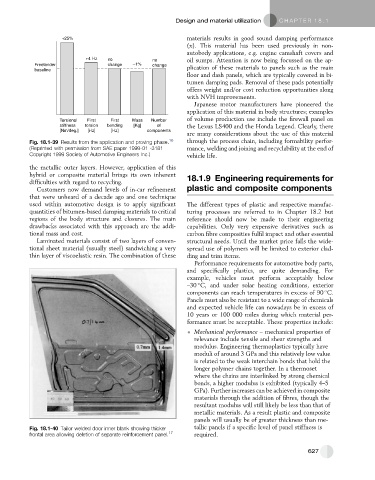Page 616 - Automotive Engineering Powertrain Chassis System and Vehicle Body
P. 616
Design and material utilization C HAPTER 18.1
+25% materials results in good sound damping performance
(x). This material has been used previously in non-
autobody applications, e.g. engine camshaft covers and
+4 Hz no no oil sumps. Attention is now being focussed on the ap-
Freelander change –1% change
baseline plication of these materials to panels such as the main
floor and dash panels, which are typically covered in bi-
tumen damping pads. Removal of these pads potentially
offers weight and/or cost reduction opportunities along
with NVH improvements.
Japanese motor manufacturers have pioneered the
application of this material in body structures; examples
Torsional First First Mass Number of volume production use include the firewall panel on
stiffness torsion bending [Kg] of the Lexus LS400 and the Honda Legend. Clearly, there
[Nm/deg.] [Hz] [Hz] components
are many considerations about the use of this material
Fig. 18.1-39 Results from the application and proving phase. 16 through the process chain, including formability perfor-
(Reprinted with permission from SAE paper 1999-01 -3181 mance, welding and joining and recyclability at the end of
Copyright 1999 Society of Automotive Engineers Inc.) vehicle life.
the metallic outer layers. However, application of this
hybrid or composite material brings its own inherent 18.1.9 Engineering requirements for
difficulties with regard to recycling.
Customers now demand levels of in-car refinement plastic and composite components
that were unheard of a decade ago and one technique
used within automotive design is to apply significant The different types of plastic and respective manufac-
quantities of bitumen-based damping materials to critical turing processes are referred to in Chapter 18.2 but
regions of the body structure and closures. The main reference should now be made to their engineering
drawbacks associated with this approach are the addi- capabilities. Only very expensive derivatives such as
tional mass and cost. carbon fibre composities fulfil impact and other essential
Laminated materials consist of two layers of conven- structural needs. Until the market price falls the wide-
tional sheet material (usually steel) sandwiching a very spread use of polymers will be limited to exterior clad-
thin layer of viscoelastic resin. The combination of these ding and trim items.
Performance requirements for automotive body parts,
and specifically plastics, are quite demanding. For
example, vehicles must perform acceptably below
–30 C, and under solar heating conditions, exterior
components can reach temperatures in excess of 90 C.
Panels must also be resistant to a wide range of chemicals
and expected vehicle life can nowadays be in excess of
10 years or 100 000 miles during which material per-
formance must be acceptable. These properties include:
Mechanical performance – mechanical properties of
relevance include tensile and shear strengths and
modulus. Engineering thermoplastics typically have
moduli of around 3 GPa and this relatively low value
is related to the weak interchain bonds that hold the
longer polymer chains together. In a thermoset
where the chains are interlinked by strong chemical
bonds, a higher modulus is exhibited (typically 4–5
GPa). Further increases can be achieved in composite
materials through the addition of fibres, though the
resultant modulus will still likely be less than that of
metallic materials. As a result plastic and composite
panels will usually be of greater thickness than me-
Fig. 18.1-40 Tailor welded door inner blank showing thicker tallic panels if a specific level of panel stiffness is
frontal area allowing deletion of separate reinforcement panel. 17 required.
627

